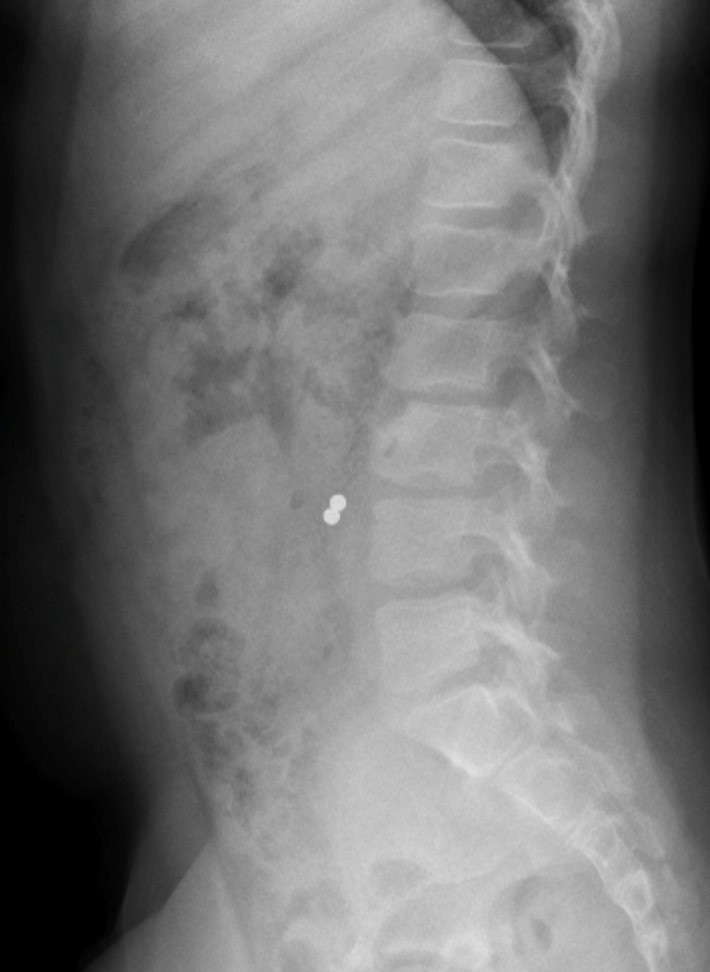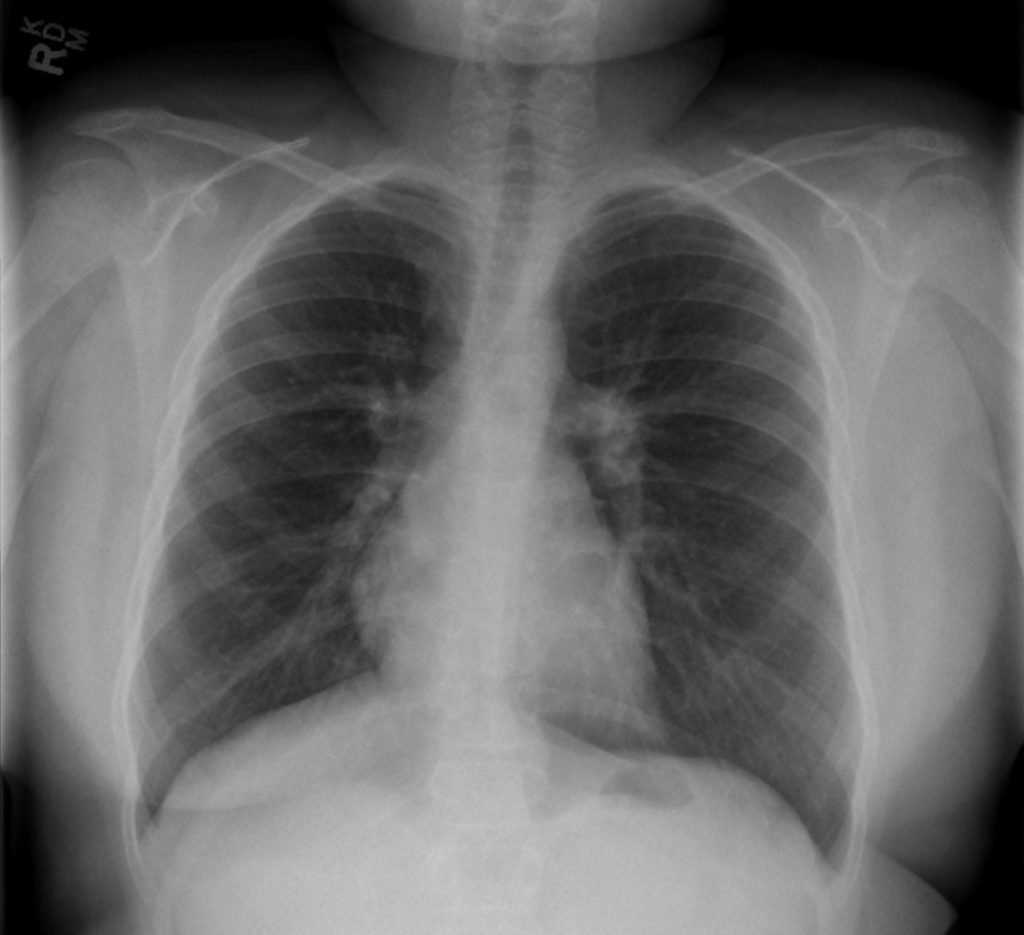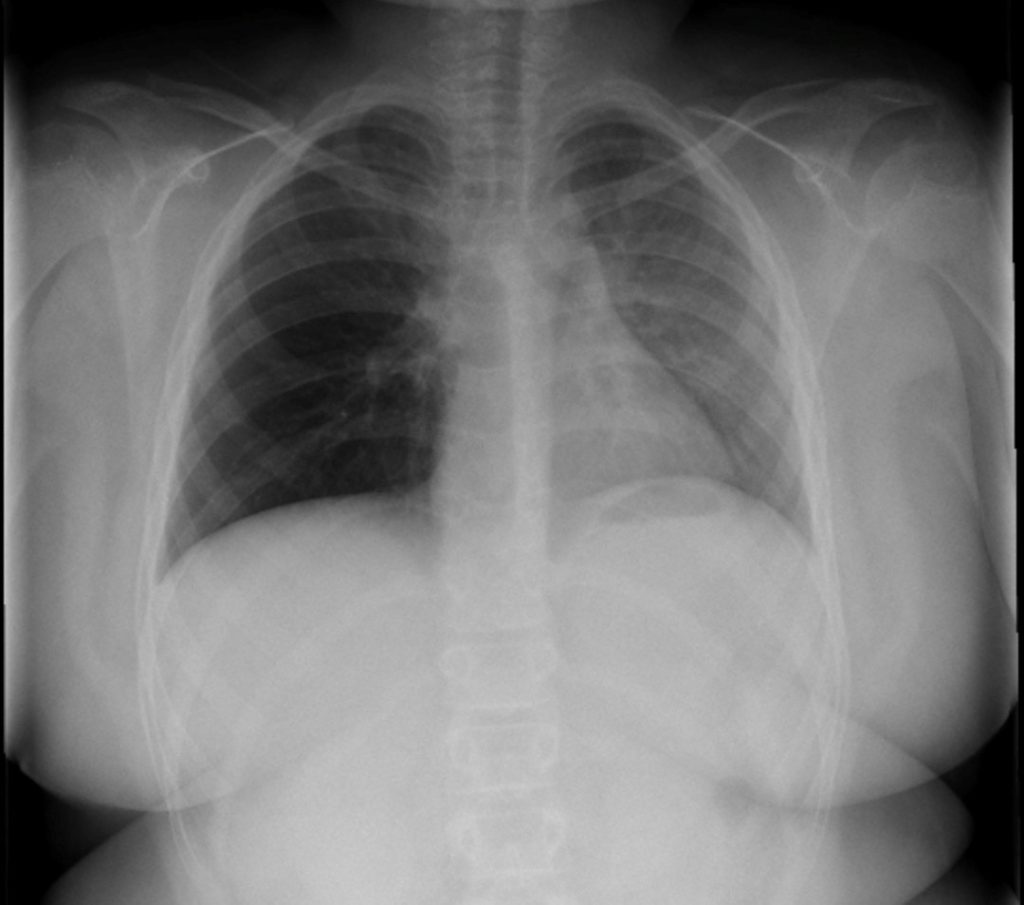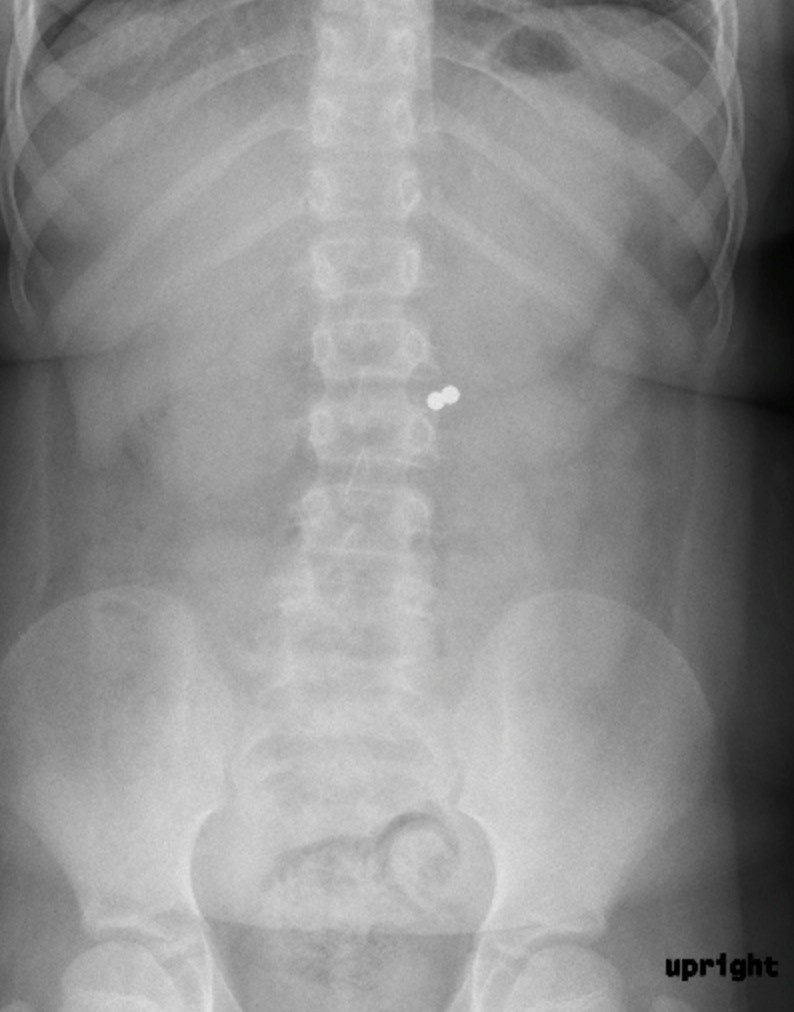101
Case 1
Ingestion
Clinical:
History – This 5 year old girl swallowed two magnets.
Symptoms – None.
Physical – No significant findings.
DDx:
Swallowed foreign body
Imaging Recommendation
X-rays

Imaging Assessment
Findings:
Two small metallic opacities were seen on the x-rays in the mid-abdomen. They were persistently, apparently, connected to to each other on all images. There was no interposed space or soft tissue between the two opacities
Interpretation:
Swallowed small magnets.
Diagnosis:
Swallowed foreign bodies.
Discussion:
- The majority of swallowed foreign bodies occur between the ages of 6 months and 6 years. Over 80% pass through the intestinal tract spontaneously.
- Food or true foreign body ingestions include, coins, toys, chicken bones (opaque), and fish bones (non-opaque).
- Most often, ingested foreign bodies impact just below the cricopharyngeus at the level of C5-C6 (70%), the level of the thoracic inlet, at the aortic arch (20%), or at the level of the esophagogastric junction (10%). Once past the esophagus, most foreign bodies will pass through the gastrointestinal tract.
- The major complications of ingested foreign bodies are perforation, obstruction, or stricture formation. Disk batteries and magnets pose particular hazards. Button batteries should be removed from the esophagus urgently because of their ability to produce perforation. Multiple small magnets also pose the risk of perforation by drawing apposing segments of bowel together and should be removed, if possible.
X-ray findings may include:
- The ability to detect a foreign body on x-rays depends upon the amount of metal it contains and whether it can be surrounded by, or contain gas, inside of it.
- Some foreign bodies will not be visible on x-rays but they may be associated with bowel obstruction.
Case 2
Aspiration
Clinical:
History – Choking/coughing spell. This 14 year old girl had piece of carrot in her mouth and experienced a prolonged choking/coughing spell (10 – 15 minutes). The carrot was not expelled with coughing. The patient was not sure if she had swallowed the carrot fragment.
Symptoms – Mild shortness of breath.
Physical – There was no air movement heard in the right hemithorax. Rhonchi were heard, loudest over the right hemithorax. Nil else.
DDx:
Aspirated foreign body
Swallowed foreign body
Normal
Imaging Recommendation
Chest x-ray – Inspiration/Expiration


Imaging Assessment
Findings:
There was diminished vascularity in the right lung. The right lung was hyperinflated on the inspiration view. With expiration the right lung remains aerated and does not deflate.
Interpretation:
The patient has a non-visible foreign body in the right bronchial tree that created a check-valve obstruction, allowing air to enter the lung on inspiration but then obstructed the bronchus on expiration.
Diagnosis:
Check-valve foreign body in the right bronchial tree
Discussion:
Foreign body aspiration is seen for the most part in older infants and toddlers. The story is usually one of a sudden choking episode while the child was eating, possibly something that they were not mature enough to masticate. Aspirated substances include nuts, seeds, popcorn, raw vegetables, such as carrots and celery, and hot dogs. On occasion, the episode occurs when the child is chewing on a small object, a toy, or a detachable portion of a toy. If the object lodges in the larynx, asphyxiation results unless the Heimlich maneuver or back blows are performed promptly.
In the majority of cases the foreign material clears the larynx and lodges in the trachea or a bronchus (more commonly, the right main because of its more vertical orientation). After the choking/coughing spell, there is a silent period usually lasting up to several hours (occasionally days or weeks), after which the child develops cough, stridor (if the object is lodged in the trachea) or wheezing (if it is lodged in a bronchus), and respiratory distress. In this acute phase, when the object is situated in a bronchus, wheezing may be unilateral and associated with decreased breath sounds. Later, diffuse wheezing may be heard, simulating asthma or bronchiolitis.
Lateral neck and chest radiographs may reveal aspirated objects that are radiopaque or outlined by the air column, enabling localization before endoscopy. However, most cases involve materials not visible on radiographs, although other radiographic clues may be present.
Partial obstruction of a bronchus creates a check-valve effect, allowing air in during inspiration but preventing its egress on expiration. This produces hyperinflation of one or more lobes of the lung on the same side as the foreign body, which may be evident on the plain chest film. The check-valve effect is accentuated on expiration.
X-ray findings may include:
- The ability to detect a foreign body is dependent upon how much metal it contains, if it can be outline by gas, or it contains gas inside a visible wall.
- If the patient has wheezing or one of the lungs is under or over inflated expiration chest images should be obtained to determine if there is a ball-valve, or check-valve, type of obstruction.
- Resorptive atelectasis may occur if the bronchus is totally obstructed.
Attributions
Figure 15.4A AP Abdominal X-ray of a foreign body by Dr. Brent Burbridge MD, FRCPC, University Medical Imaging Consultants, College of Medicine, University of Saskatchewan is used under a CC-BY-NC-SA 4.0 license.
Figure 15.4B Lateral abdominal x-ray of a foreign body by Dr. Brent Burbridge MD, FRCPC, University Medical Imaging Consultants, College of Medicine, University of Saskatchewan is used under a CC-BY-NC-SA 4.0 license.
Figure 15.5A Chest x-ray of foreign body on inspiration by Dr. Brent Burbridge MD, FRCPC, University Medical Imaging Consultants, College of Medicine, University of Saskatchewan is used under a CC-BY-NC-SA 4.0 license.
Figure 15.5B Chest x-ray of foreign body on expiration by Dr. Brent Burbridge MD, FRCPC, University Medical Imaging Consultants, College of Medicine, University of Saskatchewan is used under a CC-BY-NC-SA 4.0 license.

